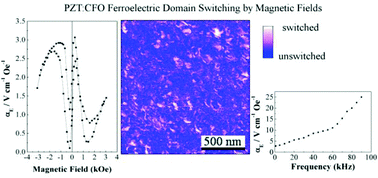Switchable 3-0 magnetoelectric nanocomposite thin film with high coupling†
Abstract
A mixed precursor solution method was used to deposit 3-0 nanocomposite thin films of PbZr0.52Ti0.48O3 (PZT) and CoFe2O4 (CFO). The piezoelectric behavior of PZT and magnetostrictive behavior of CFO allow for magnetoelectric (ME) coupling through strain transfer between the respective phases. High ME coupling is desired for many applications including memory devices, magnetic field sensors, and energy harvesters. The spontaneous phase separation in the 3-0 nanocomposite film was observed, with 25 nm CFO particle or nanophases distributed in discrete layers through the thickness of the PZT matrix. Magnetic-force microscopy images of the nanocomposite thin film under opposite magnetic poling conditions revealed in-plane pancake-like regions of higher concentration of the CFO nanoparticles. The constraints on the size and distribution of the CFO nanoparticles created a unique distribution in a PZT matrix and achieved values of ME coupling of 3.07 V cm−1 Oe−1 at a DC bias of 250 Oe and 1 kHz, increasing up to 25.0 V cm−1 Oe−1 at 90 kHz. Piezo-force microscopy was used to investigate the ferroelectric domain structure before and after opposite magnetic poling directions. It was found that in this nanocomposite, the polarization of the ferroelectric domains switched direction as a result of switching the direction of the magnetization by magnetic fields.

- This article is part of the themed collection: International Year of the Periodic Table: Applications for magnetic materials


 Please wait while we load your content...
Please wait while we load your content...